
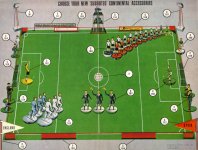
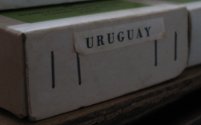
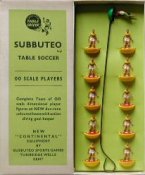
| Peter Upton's |
Subbuteo Tribute Website. |
|
The Team Colours Project. |
|
Appendix
: The 1966 World Cup. |




In the team lists of the 1960s and early 1970s there was a strange lack of International sides. England were sometimes shown as reference 10, the white/black combination that was also West Germany, but that wasn't really accurate. They did not appear in the large 1969 catalogue at all. This lack may be partially covered by the separate ranges that were produced for the 1966 and 1970 World Cups.
The 1966 range arrived with its own simple four page leaflet shown above. This leaflet simply listed the sixteen teams at the world cup with their official FIFA colours, whilst on the reverse was a colour picture advertising the continental accessory range. All these teams were available to order from Subbuteo (in the OO scale range only) "by stating the name of the team." The 1966 teams were originally produced in the old "short sleeved" heavyweight figure, and all teams should have metal handled goalkeepers.
The list eventually migrated to the standard catalogues for 1967-68, but the full range did not hang around for long. The complete range is in the 1968 catalogue (dated December 1967). However, by the 1968-69 catalogue (dated May 1968) the list had been simplified. On this new list, standard reference numbers replaced nine of the teams. At that time, if you wanted Russia, Switzerland, or North Korea, you just ordered ref No 1 from the original range; France and Italy were No 2, Portugal was 18, Bulgaria 21, Spain 48, and Brazil 50. That left just seven unique World Cup teams available to order.
The Original Short-sleeved Teams.


These are also shown on the old heavyweights page.
The original list of teams is shown in the table below. I have added some extra columns to show which teams were still on the 1968 list, which of them qualified for 1970, and some other valid notes. There are some quirks. Of course there are, this is Subbuteo.
|
Team |
Jersey |
Shorts |
Socks |
1968 list? | 1970? | Notes |
| Argentina | Light blue and white vertical stripes | Black | Grey | Yes | No | Becomes 67 in 1970-71 |
| Brazil | Yellow, green collar and cuffs | Blue with white strip | Green and yellow | Ref 50 | Amended kit | Ref 50 |
| Bulgaria | White | White | White | Ref 21 | New strip | |
| Chile | Red | Blue | White | Yes | No | Becomes 68 in 1970-71 |
| England | White | Blue | White | Yes | Yes | Became 154 |
| France | Blue | White | Red | Ref 2 | No | A new France introduced at 164 |
| Hungary | Wine red | White | Green | Yes | No | ---- |
| Italy | Blue | White | Blue with white top | Ref 2 | Yes | Became 166 |
| Mexico | Green | White | Green | Yes | Yes | Became 157 |
| North Korea | Red or dark Blue | White | Red and white or dark blue and white | Ref 1 | No |
North Korea stay on ref 1 for years. |
| Portugal | White | Blue | Blue with white top | Ref 18 | No | Ref 281 only arrives in 1978 |
| Russia | Red | White | Red | Ref 1 | Amended kit | New strip becomes 161 |
| Spain | Red | Blue | Black with red and yellow border | Ref 48 | No | Might be different |
| Switzerland | Red | White | White with red rings at the top | Ref 1 | No | New strip at 114 in 1973-74 |
| Uruguay | Sky-blue | Black | Black with blue border | Yes | Yes | Became 163 in 1973-74 |
| West Germany | White with black collar | Black | Black with white top | Yes | Amended kit | Diff. socks to 156 |
Classic Heavyweights and the 1966 World Cup list.
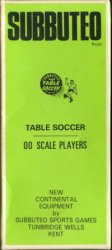
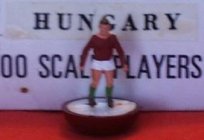

Regular heavyweight collectors will recognise the aforementioned 1968 catalogue as the change-over point between old heavyweights and the classic long sleeve figure. We know that teams like the early hooped ref 40 Crystal Palace, which makes its final appearance in 1968, were painted on the classic heavyweight (in the ohw box). This means, in theory, that all the original 1966 teams shown above could have been painted onto classic heavyweight figures.
What is certain is that the reduced list from the 1968-69 catalogue was definitely produced in the classic figure. In fact, the simplified list continued to feature in the 1969-70 catalogue with the replacement 1970 World Cup list debuting in 1970-71. This runs us into another important change in the teams, the switch to green plastic goalkeeper rods. The 1968-69 catalogue still calls these "wires" whereas the 1969-70 catalogue is calling them "rods" suggesting that this is the changeover point.
Further to this, 1968 saw a new box type being introduced. This is the more familiar classic h/w box, and in this early incarnation has a footballer logo kicking to the left. This is not as common as the later version with the right kicking logo. Both these boxes have an end profile which states "OO scale players". In my experience, the teams that have unique identifiable 1966 versions (i.e. Hungary, West Germany etc) will be found in the "left-kicking logo" box, and teams in this box always have metal goalkeepers. Subbuteo is pretty flexible though, so I expect exceptions exist. (see the Argentina below for an example).
There is also a label change at some point. The earlier labels are narrower, and have letters that are more widely spaced. The pictures for the 1970 World Cup below show this clearly.
So what happens to our remaining seven 1966 teams? Well, when the new 1970 range arrives in 1970-71, England, Mexico and Uruguay all transfer directly to the new tournament with no kit alterations. West Germany also move across, but reverse their socks to white with a black top. Argentina and Chile do not qualify for 1970. They continue in the 1966 World Cup range until 1969-70 (that catalogue has 61 reference numbers). They then arrive in the standard range in 1970-71 as references 67 and 68.
That leaves poor old Hungary as the odd man out. For some reason it doesn't get a reference number and so leaves the range. Hungary don't return to the team range until 1978 when they share a standard red shirted team with Portugal. As far as I know, the delightful claret shirted Hungary is unique to the 1960s.
A Spanner in the (dating) Works.....
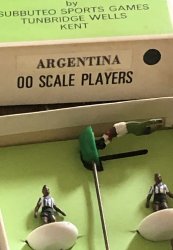
As I was working on this page, I was sent an e-mail from Jon Rosten with pictures of three World Cup 1966 teams. The Argentina shown above is a strange mix of team and box. It is a short-sleeved h/w and the base of the box is the proper early version that matches this style of team. However, the lid is the later 1968 version (with left kicking logo).
Subbuteo have always given good support to the World Cup finals, and have tried to produce all the teams who have qualified for each tournament.
The 1970 World Cup.
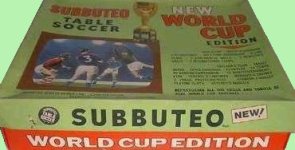
The 1970 World Cup saw a repeat of the coverage given to the 1966 competition, with all the qualifiers available to purchase. Only about four of the kits were the same as 1966, and in addition the 1970 teams now had plastic handled goalkeepers. The 1970-71 price list was the first to show these teams and the colours are as laid out below. It was stated that these were "listed as official FIFA colours". Once again, the teams were in named boxes, using printed sticky labels. The number range in 1970 stood at 75, and only Brazil were already included. These teams tend to be in the early 1970s box with the right kicking logo (however, they do run into the later boxes - see below).
In the selection illustrated below, please note that England and Uruguay have the earlier 1966 style of label. These are narrower, and the letters can be spaced farther apart. Both these teams were in both 1966 and 1970 team selections, so it is difficult to know whether these are 1966 teams with plastic goalkeepers and the updated box, or 1970 teams with the old label! Does it actually matter? It is probably the case that Subbuteo Sports Games had more than one printing machine, and maybe more than one "factory" producing these items.




|
Team |
Jersey |
Shorts |
Socks |
Number? |
| Belgium | Red, yellow/black collar and cuffs | Black | Red with Y/B tops | Became 151 |
| Brazil | Yellow, green collar and cuffs | Blue | White socks, green tops | Same as 50 |
| Bulgaria | White, red and green collar | Green | Red | Became 152 |
| Czechoslovakia | White, red and blue band | White | White with red/blue tops | Became 153 |
| England | White | Navy blue | White | Became 154 |
| El Salvador | Blue, white collar and cuffs | Blue | Blue | Became 155 |
| Israel | White with blue emblem | White | White | Became 113 |
| Italy | Blue | White | Blue with white tops | Became 166 |
| Mexico | Green | White | Green | Became 157 |
| Morocco | Red | White | Red with green tops |
Became 158 |
| Peru | White, red diagonal band | White | White with red tops | Became 159 |
| Rumania | Yellow | Blue | red, blue and yellow tops | Became 160 |
| Russia | Red | White | White with red tops | Became 161 |
| Sweden | yellow, blue collar and cross | Blue | Blue socks with yellow tops | Became 162 |
| Uruguay | Sky-blue | Black | Black with blue tops | Became 163 |
| West Germany | White, black collar and cuffs | Black | White socks, black tops | Became 156 |
In the real event, Czechoslovakia did not wear the lovely chest band, El Salvador wore white shirts in all three matches, and Israel had attractive sky blue trim on their white shirt, which might have been better than relying on a "blue emblem", one of the very few badges Subbuteo painted.
A normally reliable source told me many years ago, that a seventeenth 1970 World Cup team was very briefly produced - and that was Honduras. The theory was that Subbuteo did not know which team was going to qualify when the range was first designed. I wasn't advised what colours this team was painted in (to avoid it becoming a repaint target). I was left to find one! All these years later, and nothing has turned up. The El Salvador vs Honduras clashes are infamous because they led to the "football war" between the two countries. However, the ties (including neutral replay) were all played in June 1969, and the winner still had a two-legged tie with Haiti in September 1969 to negotiate. So is this one a myth?
Named Box Teams after the World Cup.

The named box teams continued in two more of Subbuteo's yearly catalogues after the World Cup. In 1971-72 they still had a whole page, and the 1970 result has been added to the World Cup History table. In 1972-73 as the standard team range expanded up to 106, they are reduced to a small side bar. In the 1973-74 catalogue they have all been added to the standard team charts between No 151 and 166, with the exception of Israel. Israel did arrive in the same catalogue, but at reference 113 where they shared a kit with Zurich in the Swiss range of numbers.
What this means (to my surprise), is that the named world cup teams just about survive into another box type. The mid-1970s box, with its larger logo arrived circa 1973-74. The reference numbers below 106 do frequent the earlier boxes, but I have struggled to find teams in numbered boxes in the "OO scale player" boxes later than reference 102. However, looking at heavyweight teams on various websites shows that the new box (which now states OO Scale Team on the end flap) does house the occasional World Cup team.

In addition, teams have been sighted with both the name sticker, and a reference number. The illustrated Russia team is in the earlier box too. Was this unsold stock going out on the new number? Or is the number just a modern copy?
The 1974 World Cup.
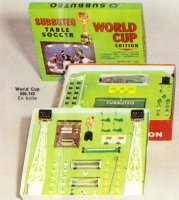
With the expansion of the normal team list, most of the 1974 qualifiers were already in the range. The exceptions to this were the three minnows of the competition. Unlike previous World Cups, these teams were simply added to the normal team range with little fanfare. Whether this was because England failed to qualify for this World Cup is open to question. The World Cup box set is also little altered from the previous competition.
|
Team |
Number |
| Australia |
174 |
| Haiti |
175 |
| Zaire |
176 |
For the record, the other finalists were: Argentina (67), Brazil (50), Bulgaria (152), Chile (68), East Germany (18), Holland (13), Italy (166), Poland (39), Scotland (149), Sweden (162), Uruguay (163), Yugoslavia (149) and West Germany (156).
The 1978 World Cup.
Among the sixteen sides qualifying for the 1978 World Cup finals, only Iran wore different colours than those already on offer (Tunisia just wore the standard red/white kit). It's worth noting the huge increase in team numbers between 1974 and 1978. This is the last World Cup of the heavyweight era, and the only one in the zombie period. The 162 Sweden, and the new Iran are perhaps the only qualifiers that seems to be rare as a zombie.
|
Team |
Number |
| Iran |
322 |
The other qualifiers for 1978 were: Argentina (67), Austria (10), Brazil (50), France (164), Holland (13), Hungary (281), Italy (166), Mexico (157), Peru (159), Poland (39), Scotland (318), Spain (48), Sweden (162), Tunisia (1), and West Germany (156).
The 1982 World Cup.
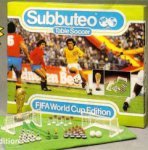
For the World Cup finals in Spain, the number of qualifiers increased from sixteen teams to twenty four. These teams were issued in a special team box, with the front of the box stating World Cup Team, along with a stripe in the Spanish colours. There is also a pre-World Cup version of the box which mentions all the teams in the qualifying draw, but only the teams that made it to the finals appear in the World Cup box. Among these are four teams appearing for the first time, and listed below.
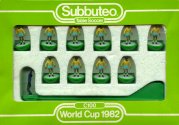
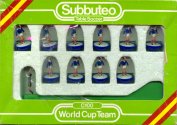
|
Team |
Number |
| Algeria |
402 |
| Cameroon |
403 |
| Kuwait |
404 |
| Honduras |
405 |
The other teams to look for in this box are Argentina (67), Austria (10), Belgium (21 or 151), Brazil (50), Chile (68), Czechoslovakia (231), El Salvador (155), England (329), France (164),Hungary (281), Italy (166), New Zealand (156), Northern Ireland (393), Peru (159), Poland (39), Scotland (318), Spain (48), USSR (161), West Germany (156), and Yugoslavia (149).
The 1986 World Cup.
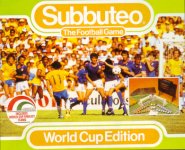
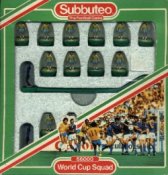
Again, Subbuteo issued the twenty four qualifying teams in special World Cup boxes, but this time they made them World Cup squads - teams of sixteen players including two goalkeepers. Actually, the 1986 catalogue shows thirty special World Cup squads including six teams that ended up not qualifying. I guess the last few places hadn't been decided. These extra teams do seem to have been produced, as a couple have been sighted.
The twenty four qualifiers were as follows - Algeria (402) Argentina (457), Belgium (499), Brazil (410), Bulgaria (152), Canada (214), Denmark (636), England (569), France (571), Hungary (635), Italy (415), Mexico (610), Morocco (481), Northern Ireland (393), Paraguay (634), Poland (412), Portugal (531), Scotland (614), South Korea (214), Spain (48 although 433 would make more sense), Iraq (21)*, USSR (392), Uruguay (397) and West Germany (445)
The six non-qualifiers were Australia (028), Austria (453), Holland (416), Ireland (471), Peru (455) and Wales (573)
*In the 1986 catalogue, Iraq are strangely listed out of alphabetical order (between Spain and USSR). In addition, they were listed as ref 021 - the all white kit. In fact, Iraq received its own numbered kit (637) which was all green with white trim. It is also worth noting that Canada and South Korea shared a reference number (214). I am not sure if the box is a combined one.
The two national sides in the range for the first time are:
|
Team |
Number |
| Iraq |
637 |
| Paraguay |
634 |
The 1990 World Cup.
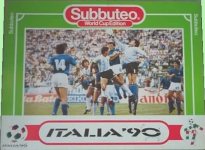
Along with new England home and away strips (719 and 720), a new Romania (718), and a USA (717) , there were four new entrants to the Subbuteo World Cup family. There were no new boxes this time, but the squad boxes were used again with only an Italia 90 sticker to tell them apart from the 1986 versions.
The two catalogues that cover the Italia 90 World Cup don't actually list the teams available. The 1990 catalogue had two pages of national sides that looked reasonable, but there were several qualifiers missing, and eight teams shown who were not at the finals. It also showed some away kits, which I've included.
The qualifiers, and their reference numbers of that year seem to be - Argentina (457), Austria (453), Belgium (649), Brazil (410), Cameroon (403)*, Columbia (713), Costa Rica (714), Czech (231), Egypt (716), England (home 653, away 682), Germany (home 681, away 393), Holland (689) Italy (home 415, away 443), Rep. Ireland (699), Romania (718), Scotland (home 680, away 710), South Korea (214), Soviet Union (696), Spain (433), Sweden (316), United Arab Emirates (715) USA (717), Uruguay (397), and Yugoslavia (149).
*Cameroon don't appear in the 1989 or 1990 catalogues, but reappear in 1991.
|
Team |
Number |
| Colombia |
713 |
| Costa Rica |
714 |
| United Arab Emirates |
715 |
| Egypt |
716 |
The 1994 World Cup.
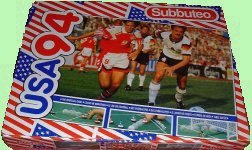
This was the final World Cup that Waddingtons supported with specially released teams, and three more first-time minnows made the team lists. In addition, there was a special USA strip, with "USA '94" printed on the shirts (773) , which seems to have been launched prior to the World Cup. There were no special boxes this time around, and no squad teams either.
|
Team |
Number |
| Bolivia |
808 |
| Nigeria |
810 |
| Saudi Arabia |
807 |
Switzerland was also produced at reference 809, but this was more of a re-issue of team 114, which had disappeared in the early 1990s.
The 1998 World Cup.
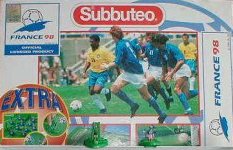
By 1998, Waddingtons had been bought by Hasbro, and Subbuteo popularity was waning. Although an attractive World Cup 1998 boxed edition was produced, individual team production had all but ceased. So Jamaica, South Africa and the other smaller national sides of that competition missed the chance to appear in the official Subbuteo range.
Since 1998, no new World Cup products have been issued. Although the photo-real version was in the shops for the 2006 event, no licence was obtained. The popular Corinthians range never misses a chance to re-issue its players in international kits, and it would have been nice if Subbuteo had managed something similar.
[ Main Page ]